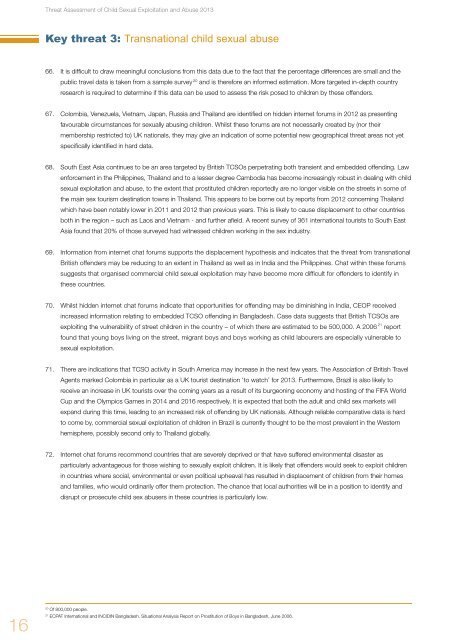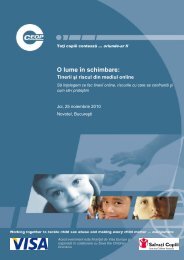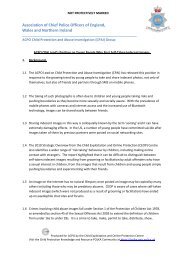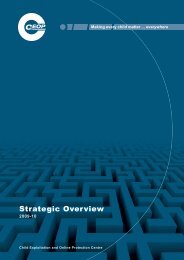Threat Assessment of Child Sexual Exploitation and Abuse - Ceop
Threat Assessment of Child Sexual Exploitation and Abuse - Ceop
Threat Assessment of Child Sexual Exploitation and Abuse - Ceop
You also want an ePaper? Increase the reach of your titles
YUMPU automatically turns print PDFs into web optimized ePapers that Google loves.
<strong>Threat</strong> <strong>Assessment</strong> <strong>of</strong> <strong>Child</strong> <strong>Sexual</strong> <strong>Exploitation</strong> <strong>and</strong> <strong>Abuse</strong> 2013<br />
Key threat 3: Transnational child sexual abuse<br />
66. It is difficult to draw meaningful conclusions from this data due to the fact that the percentage differences are small <strong>and</strong> the<br />
public travel data is taken from a sample survey 20 <strong>and</strong> is therefore an informed estimation. More targeted in-depth country<br />
research is required to determine if this data can be used to assess the risk posed to children by these <strong>of</strong>fenders.<br />
67. Colombia, Venezuela, Vietnam, Japan, Russia <strong>and</strong> Thail<strong>and</strong> are identified on hidden internet forums in 2012 as presenting<br />
favourable circumstances for sexually abusing children. Whilst these forums are not necessarily created by (nor their<br />
membership restricted to) UK nationals, they may give an indication <strong>of</strong> some potential new geographical threat areas not yet<br />
specifically identified in hard data.<br />
68. South East Asia continues to be an area targeted by British TCSOs perpetrating both transient <strong>and</strong> embedded <strong>of</strong>fending. Law<br />
enforcement in the Philippines, Thail<strong>and</strong> <strong>and</strong> to a lesser degree Cambodia has become increasingly robust in dealing with child<br />
sexual exploitation <strong>and</strong> abuse, to the extent that prostituted children reportedly are no longer visible on the streets in some <strong>of</strong><br />
the main sex tourism destination towns in Thail<strong>and</strong>. This appears to be borne out by reports from 2012 concerning Thail<strong>and</strong><br />
which have been notably lower in 2011 <strong>and</strong> 2012 than previous years. This is likely to cause displacement to other countries<br />
both in the region – such as Laos <strong>and</strong> Vietnam - <strong>and</strong> further afield. A recent survey <strong>of</strong> 361 international tourists to South East<br />
Asia found that 20% <strong>of</strong> those surveyed had witnessed children working in the sex industry.<br />
69. Information from internet chat forums supports the displacement hypothesis <strong>and</strong> indicates that the threat from transnational<br />
British <strong>of</strong>fenders may be reducing to an extent in Thail<strong>and</strong> as well as in India <strong>and</strong> the Philippines. Chat within these forums<br />
suggests that organised commercial child sexual exploitation may have become more difficult for <strong>of</strong>fenders to identify in<br />
these countries.<br />
70. Whilst hidden internet chat forums indicate that opportunities for <strong>of</strong>fending may be diminishing in India, CEOP received<br />
increased information relating to embedded TCSO <strong>of</strong>fending in Bangladesh. Case data suggests that British TCSOs are<br />
exploiting the vulnerability <strong>of</strong> street children in the country – <strong>of</strong> which there are estimated to be 500,000. A 2006 21 report<br />
found that young boys living on the street, migrant boys <strong>and</strong> boys working as child labourers are especially vulnerable to<br />
sexual exploitation.<br />
71. There are indications that TCSO activity in South America may increase in the next few years. The Association <strong>of</strong> British Travel<br />
Agents marked Colombia in particular as a UK tourist destination ‘to watch’ for 2013. Furthermore, Brazil is also likely to<br />
receive an increase in UK tourists over the coming years as a result <strong>of</strong> its burgeoning economy <strong>and</strong> hosting <strong>of</strong> the FIFA World<br />
Cup <strong>and</strong> the Olympics Games in 2014 <strong>and</strong> 2016 respectively. It is expected that both the adult <strong>and</strong> child sex markets will<br />
exp<strong>and</strong> during this time, leading to an increased risk <strong>of</strong> <strong>of</strong>fending by UK nationals. Although reliable comparative data is hard<br />
to come by, commercial sexual exploitation <strong>of</strong> children in Brazil is currently thought to be the most prevalent in the Western<br />
hemisphere, possibly second only to Thail<strong>and</strong> globally.<br />
72. Internet chat forums recommend countries that are severely deprived or that have suffered environmental disaster as<br />
particularly advantageous for those wishing to sexually exploit children. It is likely that <strong>of</strong>fenders would seek to exploit children<br />
in countries where social, environmental or even political upheaval has resulted in displacement <strong>of</strong> children from their homes<br />
<strong>and</strong> families, who would ordinarily <strong>of</strong>fer them protection. The chance that local authorities will be in a position to identify <strong>and</strong><br />
disrupt or prosecute child sex abusers in these countries is particularly low.<br />
16<br />
20<br />
Of 800,000 people.<br />
21<br />
ECPAT International <strong>and</strong> INCIDIN Bangladesh. Situational Analysis Report on Prostitution <strong>of</strong> Boys in Bangladesh, June 2006.











